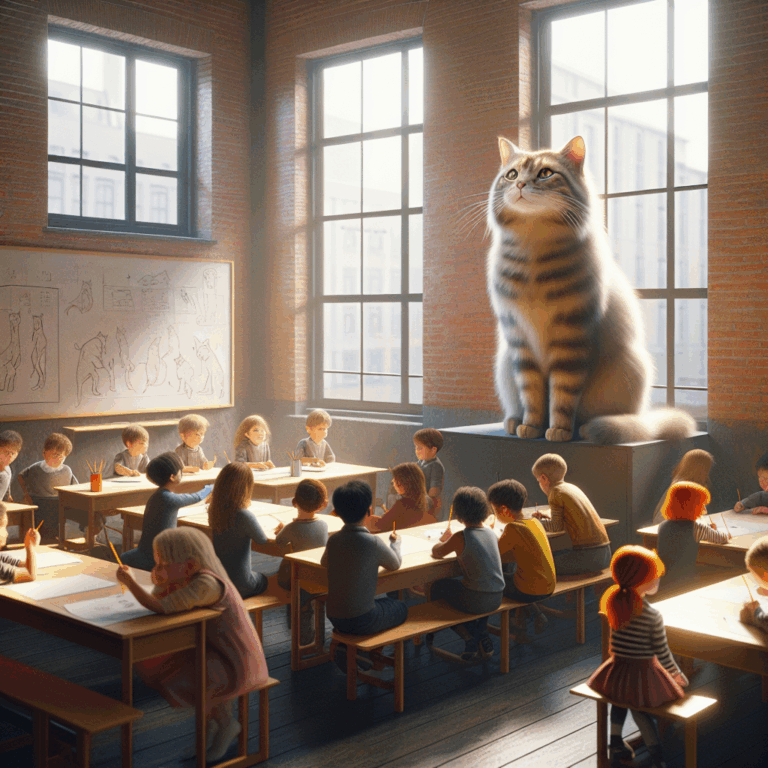The Feline Innovators of Education: Cats and Their Role in Child Development
- 13 Comments
In recent years, researchers have been delving into the unexpected yet profound impact that cats have on child development. While traditionally seen as pets, cats are now being acknowledged for their unique contributions to the cognitive and emotional growth of children. This newfound recognition is reshaping how educators, parents, and psychologists perceive the role of pets in nurturing young minds.
Cats, with their curious and independent nature, offer children a living example of exploration and learning through play. Observing a cat’s behavior can inspire children to engage in imaginative play, which is crucial for creativity and problem-solving skills. The feline knack for turning everyday objects into toys demonstrates to children the value of innovation and adaptability. As they mimic a cat’s playful antics, children learn to interact with their environment in dynamic ways, fostering a sense of curiosity and discovery.
Moreover, the presence of a cat can significantly influence a child’s emotional development. Cats are known for their calm demeanor and sensitivity to their surroundings, traits that can have a soothing effect on children. Studies have shown that children who grow up with cats often exhibit greater empathy and emotional intelligence. This is attributed to the nonverbal communication and subtle cues that cats use to express their needs and emotions, teaching children to be more attuned to the feelings of others.
The responsibility of caring for a cat also plays a critical role in a child’s development. Feeding, grooming, and attending to the needs of a pet instills a sense of responsibility and accountability in children. This daily routine not only teaches them the importance of caring for another living being but also helps in developing time management skills and discipline. The bond formed through these interactions can enhance a child’s sense of self-worth and belonging, contributing positively to their overall psychological well-being.
Educational institutions are beginning to recognize the benefits of incorporating animal-assisted programs, including cats, into their curricula. Schools have started introducing “reading to cats” programs, where children read aloud to a feline audience. This practice encourages reluctant readers to improve their literacy skills without the fear of judgment or criticism, as cats are non-judgmental listeners. The presence of a cat can create a relaxed atmosphere, making reading a more enjoyable and less stressful activity.
Furthermore, the integration of cats in therapeutic settings for children with special needs is gaining traction. Cats are being used in therapy sessions to help children with autism, ADHD, and anxiety disorders. The gentle companionship of a cat can provide comfort and stability, helping children to manage their emotions and develop social skills. The tactile experience of petting a cat can also have a calming effect, reducing stress and promoting relaxation.
As the understanding of the benefits of cats in child development continues to grow, more families and educators are embracing the idea of including these feline companions in educational and therapeutic environments. The relationship between children and cats offers a unique opportunity to foster growth, learning, and emotional health, marking a new chapter in the recognition of cats as more than just household pets but as influential contributors to childhood development.

In recent years, researchers have been delving into the unexpected yet profound impact that cats have on child development. While traditionally seen as pets, cats are now being acknowledged for their unique contributions to the cognitive and emotional growth of children. This newfound recognition is reshaping how educators, parents, and psychologists perceive the role of pets in nurturing young minds.
Cats, with their curious and independent nature, offer children a living example of exploration and learning through play. Observing a cat’s behavior can inspire children to engage in imaginative play, which is crucial for creativity and problem-solving skills. The feline knack for turning everyday objects into toys demonstrates to children the value of innovation and adaptability. As they mimic a cat’s playful antics, children learn to interact with their environment in dynamic ways, fostering a sense of curiosity and discovery.
Moreover, the presence of a cat can significantly influence a child’s emotional development. Cats are known for their calm demeanor and sensitivity to their surroundings, traits that can have a soothing effect on children. Studies have shown that children who grow up with cats often exhibit greater empathy and emotional intelligence. This is attributed to the nonverbal communication and subtle cues that cats use to express their needs and emotions, teaching children to be more attuned to the feelings of others.
The responsibility of caring for a cat also plays a critical role in a child’s development. Feeding, grooming, and attending to the needs of a pet instills a sense of responsibility and accountability in children. This daily routine not only teaches them the importance of caring for another living being but also helps in developing time management skills and discipline. The bond formed through these interactions can enhance a child’s sense of self-worth and belonging, contributing positively to their overall psychological well-being.
Educational institutions are beginning to recognize the benefits of incorporating animal-assisted programs, including cats, into their curricula. Schools have started introducing “reading to cats” programs, where children read aloud to a feline audience. This practice encourages reluctant readers to improve their literacy skills without the fear of judgment or criticism, as cats are non-judgmental listeners. The presence of a cat can create a relaxed atmosphere, making reading a more enjoyable and less stressful activity.
Furthermore, the integration of cats in therapeutic settings for children with special needs is gaining traction. Cats are being used in therapy sessions to help children with autism, ADHD, and anxiety disorders. The gentle companionship of a cat can provide comfort and stability, helping children to manage their emotions and develop social skills. The tactile experience of petting a cat can also have a calming effect, reducing stress and promoting relaxation.
As the understanding of the benefits of cats in child development continues to grow, more families and educators are embracing the idea of including these feline companions in educational and therapeutic environments. The relationship between children and cats offers a unique opportunity to foster growth, learning, and emotional health, marking a new chapter in the recognition of cats as more than just household pets but as influential contributors to childhood development.



13 thoughts on “The Feline Innovators of Education: Cats and Their Role in Child Development”
Pingback: cena kamagra 100 mg číslo 30
Pingback: discount xifaxan buy japan
Pingback: how to order rifaximin price in canada
Pingback: online order staxyn cheap fast shipping
Pingback: purchase avodart canada cost
Pingback: buying itraconazole cheap canada pharmacy
Pingback: cheapest fildena substitute sildenafil
Pingback: cheapest buy gabapentin generic online mastercard
Pingback: canadian dutasteride with no prescription
Pingback: price of flexeril cyclobenzaprine vs cialis
Pingback: buy androxal without a perscription
Pingback: generique kamagra envoyer buy online
Pingback: how to order enclomiphene overnight no rx